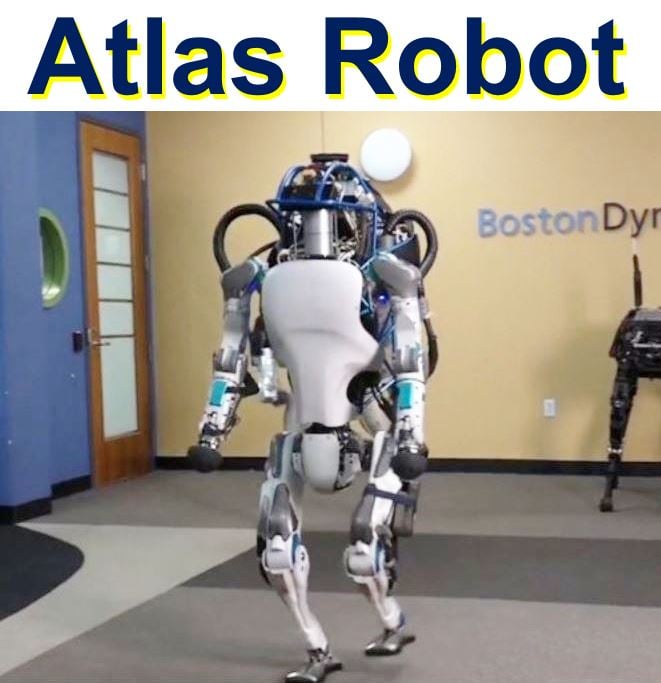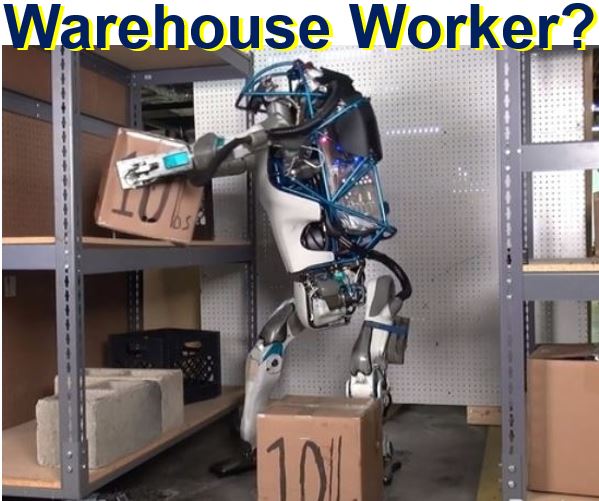If you saw a humanoid robot that takes beatings with a heavy metal ball and does not fall over, and is as nimble as a mountain goat on rough terrain and on loose debris, you would think it was incredible. That is what many people thought when they saw the video of the new Atlas robot.
Atlas had a heavy metal ball at the end of a line swung at it, but the robot’s artificial intelligence rapidly worked out where to position its torso and legs and how to swing its arms, so that it remained upright as if nothing had happened.
The upgraded anthropomorphic (looks human) robot, which has been created to operate on all types of terrain, is beginning to display movements that eerily resemble those of a human being.
 The new Atlas robot is a considerable improvement on its predecessor – it is more agile, sure-footed and human-like. (Image: Boston Dynamics)
The new Atlas robot is a considerable improvement on its predecessor – it is more agile, sure-footed and human-like. (Image: Boston Dynamics)
Standing 1.75 metres (5ft 9in) tall and weighing 82 kilograms (180 lb), the new Atlas has long arms, short legs, and a tiny cylindrical head. Its creators say it can function both outdoors and inside buildings.
Atlas has many potential uses
Atlas has potential for repetitive shop-floor jobs, such as stacking boxes or placing goods on shelves. It picks up boxes and neatly places them on shelves, and can work non-stop (as long as the batteries are charged).
Walking on snow in rough terrain is no easy task, even for a human – there is a serious risk for us of spraining an ankle or tripping over. Atlas can walk on snow with remarkable skill. When it unexpectedly steps on deep snow, it rapidly shifts its centre of gravity and calmly moves on.
What is a robot?
It can walk up to a door, grab hold of the handle, turn it daintily and open the door, walk through and close it – just like we do! In fact, its movements are so human-like that if you did not know it was a robot, you might think it was a person dressed up in a cyborg costume.
 Robotics and engineering companies across the world have been impressed by the new Atlas robot, which is eerily more human-like than ever. (Image: Twitter)
Robotics and engineering companies across the world have been impressed by the new Atlas robot, which is eerily more human-like than ever. (Image: Twitter)
Atlas recovers amazingly fast
It is possible to push Atlas to the ground if you come up behind it and shove it hard with a pole. It falls down, but manages to get up amazingly fast.
In a video released by Alphabet Inc., part of Boston Dynamics (a Google company), the speaker explains that Atlas’ control and balance system positions the feet strategically and moves the torso and arms so that it remains firmly upright, regardless of what you throw at it.
The robot is being developed with DARPA funding. DARPA stands for Defense Advanced Research Projects Agency, part of the US Department of Defense in charge of developing emerging technologies for use by the army, navy or air force.
Atlas is an all-terrain outdoor humanoid robot
Boston Dynamics, an engineering company dedicated to creating robots that move like animals, which was acquired by Google X in 2013, says Atlas was designed to operate on rough terrain.
It walks on two legs, just like we do, so that its arms are free to carry or lift things and manipulate the environment.
In particularly difficult terrains or environments, Atlas is able to move forwards or climb using both its hands and feet simultaneously, and can even crawl through tight spaces.
Its creators believe that the robot will eventually be able to do most things a human can, as well as using nearly all the tools we use.
 A warning to shelf stackers across the world. Atlas the robot is here, and can do your job amazingly well! (Image: Boston Dynamics)
A warning to shelf stackers across the world. Atlas the robot is here, and can do your job amazingly well! (Image: Boston Dynamics)
An emergency search-and-rescue robot
Atlas is intended to help emergency services in search-and-rescue operations, performing tasks such as opening doors, shutting off valves, and operating equipment in places where humans would not survive or won’t go in because they are considered too dangerous.
In 2013, the US Department of Defense said it had no interest in turning it into an offensive or defensive soldier.
In the 2015 DARPA robotics competition, Atlas showed it was able to complete the following eight tasks:
– Drive a utility vehicle.
– Travel dismounted across rubble.
– Clear an entryway that was blocked with debris.
– Enter a building by turning a door-handle and opening the door.
– Climb an industrial ladder and walk along an industrial walkway from one end to the other.
– Break through a concrete panel using a tool.
– Find and close a valve in order to stop a pipe from leaking.
– Connect a fire hose to a standpipe and turn the valve on.
When Atlas was first shown to the public in July 2013, Gary Bradski, an artificial intelligence specialist, said we now have a new species, which he called Robo sapiens.
 According to DARPA, robots should be able to operate in spaces designed for humans, use tools that are built for humans, and be controlled with the minimal of training by individuals who are not robotic experts. (Image: theroboticschallenge.org)
According to DARPA, robots should be able to operate in spaces designed for humans, use tools that are built for humans, and be controlled with the minimal of training by individuals who are not robotic experts. (Image: theroboticschallenge.org)
Robots and artificial intelligence
Remaining upright while navigating uneven terrain and automatically adjusting for unexpected complications is an extremely sophisticated process that humans and animals have because we have a brain and central nervous system.
Robots have artificial intelligence (AI). AI is a sub-field of computer science that aims to enable the development of computers (or robots) that can do things normally done by people – things associated with humans acting intelligently.
For mobile robots to be able to do what humans do competently, be it search and rescue, replacing us in certain jobs and other tasks, they will need to have ultra-advanced AI.
Rise of the robots… literally. https://t.co/P6FYCx0BoC #basicincome #AtlasRobot pic.twitter.com/KUXRrNqKFT
— Scott Santens (@2noame) 25 February 2016
What made this robot interesting for me was that when faced with an obstacle or a hard knock, it reacted in an eerily similar way to a human or animal that has been struck.
In one of the experiments, an engineer places a large box on the ground for Atlas to pick up. As he gets near it, the researcher pushes it out of its way with a stick. The robot stops and then proceeds to walk towards its new location, when the box is moved again it does the same.
While watching the researchers on the videos knocking Atlas over from behind, hitting it with a heavy metal ball, and teasing it when it tries to pick up a box, one can’t help feeling sorry for it, and wondering whether it might suddenly get fed up.
After each upgrade Atlas’ AI is becoming more sophisticated, i.e. it is getting more intelligent. Who knows whether one day, while it is being teased and baited during an experiment, it might decide enough is enough and time for the engineers to get their comeuppance?
Video – Atlas, the amazing humanoid robot
Below is a Boston Dynamics video tweeted by Arya Dega. While watching some of the tricks the researchers played on it, I could not help feeling sorry for the poor robot, even though I know it is just a machine.
After four legs auto balance, now released two legs. Its a #humanoid #robotics by @BostonDynamics https://t.co/Cn4qTExMtQ
— Arya Dega (@aryadega) 25 February 2016
Video – Artificial Intelligence
Robots have Artificial Intelligence (AI). AI refers to software technology that makes robots and other devices ‘intelligent.’ In other words, they copy how we think. They also copy how we (humans) behave.
